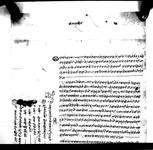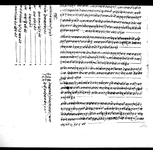A dharma bandejapatra meant to settle a jurisdictional dispute between two tālukadāras in the Aṭhāra Saya Kholā region (VS 1974)
ID: L_1200_0023
Edited and
translated by Rajendra Shakya
in collaboration with
Yogesh Budathoki
Created: 2019-11-25;
Last modified: 2021-08-12
For the metadata of the document, click here
The accompanying edition, translation/synopsis and/or commentary are available under the terms of the Creative Commons Attribution-ShareAlike 4.0 International License
Abstract
The document, a dharma bandejapatra prepared by Subbā Narajaṅga Guruṅa and handed over to Dhorje Dhaṃḍula, outlines their jurisdiction over 20 villages in the Aṭhāra Saya Kholā region, wherein they mutually agree not to interfere in the other’s village affairs.Diplomatic edition
[1r-part1]
1श्री\1श्रीलाठ्साहेव2१[seal with the legend: श्रीनरजङ्ग७२]1साछि
[table1]
| 1 | सहि लेदुदघ लेतिल चे | लमजुं३गाऊतिलच्येवस्न्येलेफ्टेंटुदघले | १1 |
| 2 | [Seal with Tibetan text belonging to Ghopā Ghyālcen Bhoṭe] | रुईगाँऊवस्न्ये:घोपाघ्यालचेन्भोटे | १ |
| 3 | [Seal of Ghopā Meta Karma Chirīṅ Bhoṭe] | ऐंवस्न्येघोपा:मेतकर्मछिरीङ्भोटे | १ |
| 4 | [Fingerprint of Ghopā Taṃjin Bhoṭe] | ऐंवस्न्येघोपातंजिन्भोटे | १ |
| 5 | [Fingerprint of Naṃgyāla Bhoṭe] | ऐंवस्न्येनंग्यालभोटे | १ |
| 6 | [Fingerprint of Syārphā Chriṃ] | ऐंवस्न्येस्यार्फाछ्रिंधर्केभोटे | १ |
| 7 | [Fingerprint of Chirīṅa Chekyāpa Bhoṭe] | १८सैषोलावीगाँऊवस्न्ये:छिरीङछेक्यापभोटे2 | १ |
| 8 | [Seal of Ṣaṃvā Chvoṃve Bhoṭe] | ऐसामागाउँवस्न्येषंवाछ्वोंवेभोटे | १ |
2वावुसुव्वाछीमीधोर्जेकोर•मेरावावासुव्वामनीलालगुरुंकापालामेल्संगकाम्गरीआ:
3याकोर•हामी२जनाकापालाकेहिअमेलभय़ाकोहोतापनीअवप्रान्तअघिकोई
4विलागकेहीनलीहाम्राजिय़ाभरतपसिलमालेषिय़ाकावन्दोवस्तवमोजिंगर्नुग
5रौंला¯¯¯ ¯¯¯ ¯¯¯ ¯¯¯ ¯¯¯ ¯¯¯ ¯¯¯
6¯ ¯१¯काषुव़ा१८सैषोला२०गाँऊअघितीम्रावावुछिमीधोर्जेलेकाम्गर्दा:तिम्रावावु
7कोरमेरावावाकासल्लाले:सो२०गाँऊमध्येरुईगाँऊ१मेरावावासुव्वामनीलालगुरुं[?]ई
8गाँऊकोकुरीय़ामासमेत्भर्नाभै:तालुक्दारीकाम्गर्ने•रअरु१९गाँऊतिम्रावावुलेकां
9गर्नेगरीआयाकोमा:६६सालमाजम्मै२०गाँऊतिम्रानाऊमापट्टाकवुलिय़ेत्गरीतीमी
10लेलियाकोर•लार्केमासाविक्सनदसव़ाल्र•थीतीमातीमीलेखिचोलागरीदीदा:
11६९साल्मामैलेजम्मै२०गाँऊकोठेक्गनीमहसुलगरी•ठेक्काकवोलगरीमेरानाऊमाप
12ट्टाकवुलिय़ेत्भै:आय़ाकोमा:७२सालसम्ममैलेकाम्गरी७३सालकावालीदेषीसो:
13२०गाँऊतिम्रानाऊमालोकाभारापट्टाभय़ाकोछतापनी:अघिदेषिमेरावावारमसमे
14त्ले:रैतिसरहतिरोतीरी•सोरुईगाँऊकोकुरीय़ामाभर्नाभैतालुक्दारीकाम्समेत्ग
15रीआय़ाकोहुनाले७३साल्कावालीमातिम्रानाऊमालोकाभारापट्टाकवुलिय़ेत्भय़ा
16कोछतापनी:सोरुईगाँऊकोदाम्काम्मैलेगरीरैतीवाटअसुल्गर्नुपर्नेठेक्सिर्तोसमे
17त्रैतीवाटअसुलगरी¯ ¯१¯कातहविल्मावुझाईरसिदभर्पाईलिंऊला¯¯¯ ¯¯¯ ¯¯¯
[1r-part2]
18लार्केमामेरावावाकापालारमेरापालामासमेत्साविक्थीतीसनदवमोजिंअघि
19जुन्रीत्संगकाम्गरीआय़ाकोहुंअवप्रान्तपनीसोहिवमोजिम्गरुंला:तेस्मासद
20रमोफ्सल्मा:ऊजुरवाजुरषर्षिचोलाकौनैकुरातिमीलेनगर्नु¯¯¯ ¯¯¯ ¯¯¯
21सर्कारलेवक्सन्ज्यालसम्म:सो१८सैषोला२०गाँऊकोतालुक्दारीकाम्:हाम्रावावाहरु:
22कापालाजस्तोगरीरुईगाँऊ१कोकाम्मैलेगर्नेर१९गाँऊकोकाम्तिमीलेगर्ने:तेस्मारु
23ईगाँऊमातीमीलेषिचोलानगर्नेर१९गाँऊपट्टिमैलेषिचोलागर्नेछैन¯¯¯ ¯¯¯ ¯¯¯
24हामि२जनावाहेक्अरुकसैलेसो२०गाँऊकोतालुकदारीकाम्मा:ठेक्काकवोलगरीली
25योवा:षिचोलागर्योभन्या:हामी२जनाकासल्लावाटसदरमोफसल्मा:जेजसोग
26र्नुपर्छसोगर्नु:गरौंला¯¯¯ ¯¯¯ ¯¯¯
27१८सैषोलापटीर३गाँऊलार्केपट्टिसमेत्:सर्कारवाटदुनिञाँकोथीतीमा:नञाँरैरकम्:
28आयोभन्याहामी२जनाकासल्लावाटसदरमोफसल्माजेजसोगर्नुपर्छगरीदुनिञाँ
29को:साविक्थितीरहनेऊद्देगगर्नु:हामी२जनालेदुनिञाँकोसाविक्थीतीमाघटीवढी
30नगर्नुगर्नेछैन:¯¯¯ ¯¯¯ ¯¯¯
31हामी२जनाकोजिय़ाभरहाम्रावावाहरुकापालाकोधर्मथामीमन्मारीसईवीर
32फट्टाहाहरुकोकुरासुनीकौनैकुरामापनीधर्मजानेरविरुदपर्नेकांकुरानगरीमा
33थिलेषीय़ाकाधर्ममारहनु:रहौंला:भनीफट्केपट्टीकासाछिहरुकारोहवरमाध
34र्मवन्देजकाकागजलेषितीमीसुव्वाधोर्जेढंडुलषुनुलाईदीञ्यौंसम्वत्१९७४साल
34भाद्रगते२३रोज६शुभं¯¯¯ ¯¯¯ ¯¯¯1सहीसु:सेर
2वाहादुरथा
3पाछेत्री1लेषकासाछीसुवेदारसेरवाहादुरथापा
2छेत्रीलमजुंपामचोक्वस्न्ये¯¯¯ ¯¯¯ ¯¯¯
Translation
[1r-part1]
[In the left margin:]
Witness[es]
[table1]
| 1 | Signature: Le[phṭena] Duda Ghale, Tilace | LephṭenaDuda Ghale, resident of Tilacye village in Lamajuṅa (Lamjung)-3 | 1 |
| 2 | [Seal with Tibetan text belonging to Ghopā Ghyālcen Bhoṭe] | Ghopā Ghyālacen Bhoṭe, resident of Rui village | 1 |
| 3 | [Seal of Ghopā Meta Karma Chirīṅ Bhoṭe] | Ghopā Meta Karma Chirīṅ Bhoṭe, resident of the same | 1 |
| 4 | [Fingerprint of Ghopā Taṃjin Bhoṭe] | Ghopā Taṃjin Bhoṭe, resident of the same | 1 |
| 5 | [Fingerprint of Naṃgyāla Bhoṭe] | Naṃgyāla Bhoṭe, resident of the same | 1 |
| 6 | [Fingerprint of Syārphā Chriṃ] | Syārphā Chriṃ (Chirīṃ?) Dharke Bhoṭe, resident of the same | 1 |
| 7 | [Fingerprint of Chirīṅa Chekyāpa Bhoṭe] | Chirīṅa Chekyāpa Bhoṭe, resident of Bi[hi] village of 18 (i.e. Aṭhāra) Saya Kholā | 1 |
| 8 | [Seal of Ṣaṃvā Chvoṃve Bhoṭe] | Ṣaṃvā Chvoṃve Bhoṭe, resident of Sāmā village of the same | 1 |
Śrī Lāṭha Sāheba3
1
[Seal with the legend: Śrī Narajaṅga 72]
Likhitam [by] SubbāNarajaṅga Guruṅa, resident of Upper Ghanapokharā of 10 thara (i.e. Daśathara) in Lamajuṅa
Āge: During the time of Chīmī Dhorje (the father of you Dhorje Dhaṃḍula) and my father Subbā Manīlāla Guruṅa, we worked in harmony, but during the time of the two of us there have been some differences. Even so, from now onwards [both you and I] shall act in accordance with the regulations mentioned in the [following] details (tapasila) for as long as we live, without any of the envy and aversion4 of the past.
When your father Chīmī Dhorje served [as tālukadāra], the practice based on consultations between your father and my father was that, of the 20 villages of the 18 Saya Kholā region which were the khuvā of [lāṭha sāheba]5 , my father, Subbā Manīlāla Guruṅa, performed tālukadārī duties in the 1 village of Rui, and was also registered as a kuriyā in it, and your father performed [those] duties in the other 19 villages.
However, in the year [VS 19]66 (1909 CE), you acquired a written lease agreement (kabuliyata), took all the 20 villages in your name, and when you quarrelled with [provisions of] previous sanadas, savālas and thitis in Lārke, a written lease agreement was drawn up in my name in the year [VS 19]69 (1912 CE) after I computed the contractual amounts for all 20 villages, paid the charges and accepted [the terms of] the contracts. I served [as tālukadāra] till the year [VS 19]72 (1915 CE), and [then] a lokābhāra contract was leased in your name for the said 20 villages for the crops of the year [VS 19]73 (1916 CE) onwards.
However, since my father and I had been paying the rent as any ryot would do, were enrolled as kuriyās of the said village, Rui, and had been doing the work of tālukadāras, a lokābhāra contract was leased in your name for the crops of the year [VS 19]73. I shall nevertheless [continue to] attend to the money matters of the said village, Rui, collecting the ṭheka and sirto taxes exacted from the ryots, submitting them to the tahabila of [the lāṭha sāheba]6 and getting receipts for the same.
[1r-part2]
From now onwards I shall, in accordance with the previous thitis and sanadas, continue to work in the manner I have been doing up to now, [both] during the time of my father and my own in Lārke. Do not file any complaints or quarrel about it in the centre or in the rural districts.
For as long as the sarkāra offers us the tālukadārī of the said 20 villages of the 18 Saya Kholā region, I shall do [this] work in the one village of Rui and you shall do it in the [other] 19 villages, just as during the time of our fathers. You will not quarrel over this [arrangement] in Rui village, and I shall not do so [over that] in the 19 villages.
In the case where someone other than the two of us accepts and acquires the contract for the tālukadārī duties in the said 20 villages or quarrels [with us over our contracts], then whatever needs to be done in the centre or in the rural districts will be done in consultation with one another.
If new rakama [offers] in the 18 Saya Kholā region or the 3 villages in Lārke [come] from the sarkāra, then after consulting with one another we shall do whatever needs to be done in the centre or in the rural districts and work towards7 maintaining the previous thitis of the people (duniñā). We two shall not add to or remove [any of] the people's previous thitis.
We shall remain true to the dharma [as] stated above—we two for as long as we live—shall adhere to the dharma from the time of our fathers, not holding any ill will [towards one another] in our minds, or listening to talk of strife and dishonest people or doing anything that goes against [the dharma], knowing [what] the dharma [calls for]. I have thus prepared [this] dharmabandeja8 and handed it over to you, Subbā Dhorje Ḍhaṃḍula Khunu, in the presence of the witnesses [recorded] in the margin of this document.
Friday, the 23rd of Bhādra in the [Vikrama] era year 1974 (1917 CE). Auspiciousness.
[In the left margin:]
Signature: SubedāraSera Bāhādura Thāpā Chetrī
Witness to the deed: Subedāra Sera Bāhādura Thāpā Chetrī, resident of Pāmacok in Lamajuṅa
Commentary
This dharma bandejapatra prepared by Subbā Narajaṅga Guruṅa and handed over to Dhorje Dhaṃḍula, divides the tālukadārī rights over 20 villages of the Aṭhāra Saya Kholā region between them. Narajaṅga is to enjoy jurisdiction over the single village of Rui, and Dhorje that of the other 19, in the manner exercised during the time of their fathers. Each also agrees not to interfere in village affairs that fall under the other’s jurisdiction.
It is clear from the document that on several occasions the two had sought to acquire the tālukadārī contract for all 20 villages secretly, that is, by trying to keep the other one completely out of the picture. At some point they came to agree not to compete with each other any longer, and thus prepared this document that clearly outlines their jurisdiction over the 20 villages.
AS a dharma bandejapatra, the present document involves moral but no legal obligations to follow its terms.


